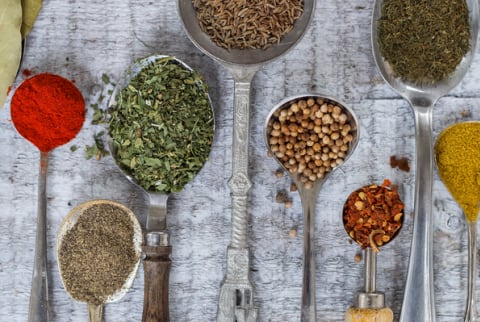Advertisement


As a health-conscious chef, I've always been a big believer in turning to your diet to help fix what ails you. But in the last year, I've really been trying to practice what I preach and take my own natural lifestyle to the next level. One of my biggest challenges has been breaking the over-the-counter pill-popping habit that so many us have.
It's so easy to open up your medicine cabinet for a quick fix — be it an Advil for a headache or something more natural, like activated Charcoal for an upset stomach. But since I try to inspire people to use their kitchens as their main avenue to living a healthier lifestyle, I've tried to find cooking solutions that can stand in for the ever-present pill. By far the easiest, and one that's rooted in thousands of years of history, is your spice rack.
Medications are great for when you're in crisis, and believe me, when I'm nursing a migraine, the last thing I want to do is stand over a hot stove or chop sweet potatoes. But using certain spices, which are high in anti-inflammatory properties, can help keep medical emergencies at bay in the first place.
I've put together a list of some of my favorite spices and their efficacies, as well as ways to use them in cooking to heal your body and spirit. Investing in your spice rack is one of the best places you can put your money. Make sure what you're using hasn't been sitting in the pantry for more than 6 months — having fresh spices, like anything, will maximize their natural efficacies.
1. Cayenne pepper to kick your cold.
As anyone who's ever gone to town on some spicy salsa knows, hot peppers like cayenne can help clear the sinuses and cause your brow to sweat. By warming the body and stimulating circulation, cayenne gets mucus moving from our repertory passages, making it a great solution for those battling the common cold. It's also one of the highest botanical sources of Vitamin C. Try using it with garlic in soups for double anti-viral duty.
2. Turmeric to soothe your aching joints and inflammation.
Curcumin, the main ingredient in turmeric, which gives it that vibrant yellow color, is one of the best anti-inflammatory agents around. It's great for joint swelling, arthritis, and headaches. Since its anti-oxidants also help protect the liver from toxins, it's a great preemptive hangover cure. Stir a teaspoon into your tea to ward off hangover headaches in the same way you would that pre-bed Advil. While Advil can hurt the liver when combined with alcohol, turmeric actually aids it. You can find Turmeric and curcumin in capsule form, but I love using it in Moroccan-inspired stews or as an affordable replacement for saffron in paella.
3. Dried ginger for nausea.
Ginger has a long history in Asian herbal traditions of alleviating gastrointestinal distress and nausea. It's been used in motion sickness trials on sailors and has been proven effective at reducing sickness at sea. While adding ginger to your food might not be as convenient as reaching for the Dramamine (though you can find ginger capsules as well), it has the added benefit of having no drowsy side effects. Ginger has been particularly popular in treating vomiting during pregnancy, without the harmful effects of anti-nausea medication, which can cause birth defects. Dried ginger is great in baked goods, granola, and trail mixes, which are all perfectly portable for curing nausea on the road.
4. Cinnamon for cramps.
Midol is one pill I'm happy to rid from my medicine cabinet. The Chinese use cinnamon bark, along with other herbs, in their treatment of menstrual cramps. Like many of the other spices on this list, cinnamon reduces inflammation and is high in antioxidants. Like cayenne, it also has a warming effect on the body, which makes it all the more soothing during times of pain.
The sticks will keep for longer but are less potent than cinnamon bought in ground form. I love using its warming, soothing effects in the morning by sprinkling some into oatmeal, smoothies, or tea. It's also an essential spice for pumpkin recipes, including pancakes!
5. Cumin, cloves, nutmeg, and cardamon for dairy-related digestive issues.
If you carry Lactaid around with you in your purse, these are the spices for you. Warming ingredients are great digestive aids, especially with mucus-forming foods like milk, yogurt, and other dairy. Adding just a ½ teaspoon of these spices to your creamy soups, smoothies or milkshakes will help your body process them all the better. Consider this a justification for loading up your apple pie with spices and then placing a scoop of vanilla ice cream on top. Cumin in particular is great for upset tummies for any reason.
6. Dried thyme for coughs and bronchitis.
Thyme has a long history of use in natural medicine, dating back to Ancient Greece. In his writings, Hippocrates mentions thyme's therapeutic uses in treating respiratory conditions. Naturopaths like to use it in conjunction with coughs, bronchitis, and chest congestion. You can of course buy fresh thyme and add it to your roasts and stews – it's great with meat. But dried thyme works just as well and can live on your spice rack. I love adding it to healthy snacks like crispy chickpeas and homemade popcorn.
7. Peppercorns as a natural decongestant.
Like cayenne, peppercorns are great for clearing out your nasal passages. But black pepper in particular contains chemicals that disrupt your mucus membranes, which means thinning them in the same way Mucinex would and making it easier to get rid of. Peppercorns also decongest your intestines – making them good for gas! Add a handful to your kettle and boil them with water for a great spicy tea. You can also add whole peppercorns to stocks and bone broths, which is what my body craves when I have a cold anyway.